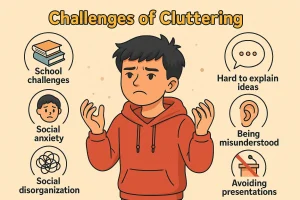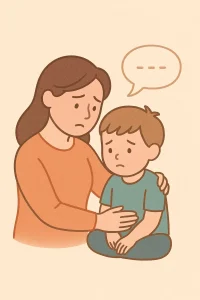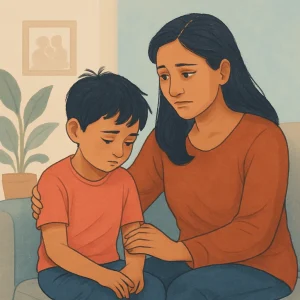Enhance Child Language Development: Guide for Parents
By Wellness Hub
Last Updated: November 26, 2024
Language is the very essence of human interaction, a foundational tool that not only allows us to express our thoughts and emotions but also connects us with the world around us. From the excited babbles of a baby to the complex discussions of adults, child language development is a fascinating journey that varies significantly across different contexts and individual experiences.
In this exploration, we delve into several crucial aspects of child language development, focusing on topics such as the myths and realities of bilingual language development, identifying signs of language delays in children, understanding speech development in children with autism, and recognizing the vital role that schools and educators play in nurturing linguistic skills.
Bilingual Language Development: Myths and Facts
Raising a bilingual child is a journey filled with excitement and unique challenges. Bilingual language development involves a child learning to understand and use two languages from an early age. This process not only enriches their communication skills but also opens up a world of cultural connections and cognitive benefits.
Bilingual Language Development Myths vs. Facts
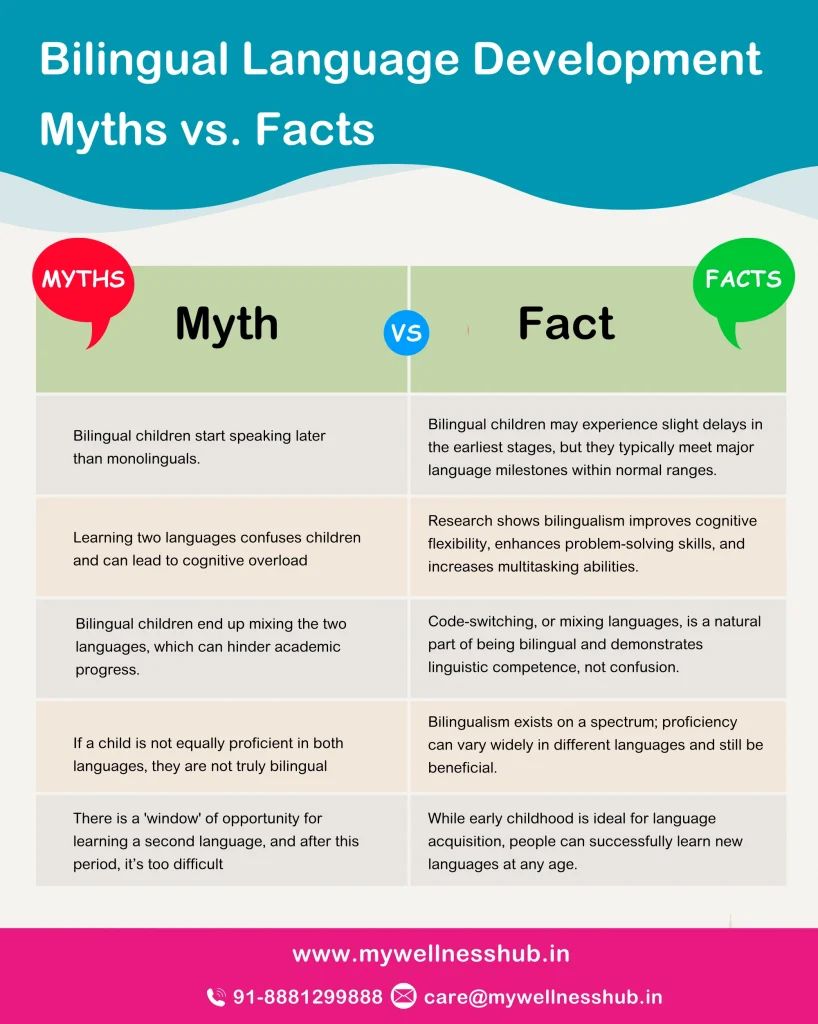
Defining Bilingual Language Development
Bilingual language development occurs when a child is consistently exposed to two languages. This exposure can happen simultaneously, with both languages being introduced from birth, or sequentially, where a second language is introduced after the first language is already established. The key is consistent interaction in both languages, tailored to everyday contexts that make the learning process natural and engaging.
Debunking Myths with Facts
Myth 1: Bilingualism causes confusion.
Fact: Research consistently shows that children who learn two languages from an early age can differentiate between the two without confusion. Their brains are incredibly adaptable, allowing them to toggle between languages according to the context.
Myth 2: Bilingual children are delayed in language skills.
Fact: While bilingual children may initially mix elements from both languages—a normal part of bilingual development—they do not lag in overall language development. In fact, they often have a better understanding of language structure and vocabulary than monolingual peers.
Myth 3: It’s too late to raise a bilingual child after a certain age.
Fact: Although early childhood is a critical period for language acquisition, it’s never too late to begin learning a new language. The plasticity of the human brain allows for language learning at any age, though the methods and speed of learning may differ.
Cognitive and Social Benefits
Being bilingual has profound effects on the brain’s executive functions, such as problem-solving, multitasking, and focusing attention. These cognitive benefits contribute to academic success and career opportunities in an increasingly globalized world. Socially, bilingual individuals often exhibit heightened empathy and understanding, as they can navigate multiple cultural perspectives.
Also Read: What is Cognitive Behavioral Therapy – A Complete Guide
Language Delays in Children: What to Look For
Understanding the typical milestones in child language development during the first three years is crucial for spotting potential delays early. Early detection paired with the right support can make a significant difference in a child’s communication skills.
Language Development Milestones from 0-3 Years
- 0-6 Months: Babies begin to coo and make pleasure sounds. They respond to their name and recognize the voices of their parents.
- 6-12 Months: Babbling starts, including sounds like “ba-ba” or “da-da”. Babies begin to respond to simple verbal requests and use gestures, such as waving goodbye.
- 12-18 Months: The vocabulary starts to build, with one or two words (other than “mama” or “dada”) typically spoken with meaning.
- 18-24 Months: Children start to combine two words, like “more milk” or “mommy go,” and add more words to their vocabulary.
- 2-3 Years: Their vocabulary explodes, and they begin forming three- to four-word sentences. Understanding and following simple instructions becomes evident.
Know more: The Early Years of Speech and Language.
Signs of Language Delays
Recognizing the signs of language delays involves comparing your child’s linguistic progress to these milestones. Here are key signs to watch for:
- By 12 Months: Limited or no babbling, or not using gestures such as pointing or waving.
- By 18 Months: Prefers gestures over vocalizations to communicate, has trouble imitating sounds, or has a very limited number of spoken words.
- By 2 Years: Can only imitate speech or actions and cannot produce words or phrases spontaneously, or has an inability to follow simple directions.
- By 3 Years: Difficulty in forming sentences, limited vocabulary, or not being understood by family or caregivers.
Speech Development in Children with Autism
Language development in children with autism spectrum disorder can be quite distinctive, presenting unique challenges and milestones that differ from neurotypical development. Understanding these differences is crucial for parents and educators to effectively support the communication growth of children with autism.
How Language Development Differs in Children with Autism
Children with autism often experience variations in their speech and language development. Some may develop language skills at a typical pace, while others might face significant delays or exhibit atypical speech patterns, including echolalia (repeating words or phrases). Additionally, non-verbal communication such as eye contact, facial expressions, and body language might also be affected, which can impact their ability to use language effectively in social contexts.
Key Speech Development Milestones to Monitor
While each child with autism is unique, certain speech and language milestones can be particularly important to monitor:
- Pre-verbal Skills: Before speaking, children with autism may use gestures or alternative communication methods, such as pictures or sign language.
- First Words: Some children with autism develop vocabulary slower than their neurotypical peers, and their first words may come later.
- Phrase Speech: Developing the ability to combine words into meaningful phrases can be delayed, often appearing after the age of 3 or 4.
- Functional Communication: The use of language for different functions such as requesting, commenting, or asking questions may be challenging and requires specific interventions.
Effective Strategies and Therapies to Support Speech Development
Supporting speech development in children with autism involves tailored strategies that address their individual needs. Here are some effective approaches:
- Speech Therapy: Working with a speech-language pathologist can help develop tailored strategies that improve both speech and non-verbal communication skills.
- Visual Supports: Many children with autism are visual learners, so incorporating pictures, videos, and visual schedules can enhance understanding and communication.
- Technology Aids: Apps and software designed for speech development can provide interactive and engaging ways to enhance communication skills.
- Social Stories and Role-Playing: These methods help children understand and practice appropriate social interactions, which can improve their communication skills in social settings.
The Role of Schools and Educators in Language Learning
Schools and educators play a critical role in shaping how children develop their language skills. By fostering a supportive and inclusive environment, they help students not only learn a new language but also enhance their overall communication abilities. This support is crucial for all students, including those learning English as a second language (ESL).
Influence of Schools and Educators
Teachers are often key in identifying students’ language needs and guiding their language learning. They use diverse strategies to engage students and encourage language use in the classroom, such as integrating language lessons into different subjects or using direct instruction.
Supportive Learning Environment for Diverse Needs
Schools address diverse language needs by creating inclusive environments that respect and value all languages. This may include:
- Bilingual Education Programs: These help students maintain their native language while learning a new one.
- Language Support Services: Services like tutoring and language workshops aid students struggling with language barriers.
- Training for Teachers: Programs that enhance teachers’ understanding of cultural differences can improve communication and support for students from various backgrounds.
Role of Play in Language Learning
Play is vital in language development. Teachers use both structured and unstructured play to help children practice and naturally use language.
- Structured Play: Activities like role-playing and storytelling encourage children to practice language in a guided setting.
- Unstructured Play: Free play and outdoor activities let children use language spontaneously with their peers, promoting social interaction and problem-solving skills.
Encouraging Language Development at Home and School
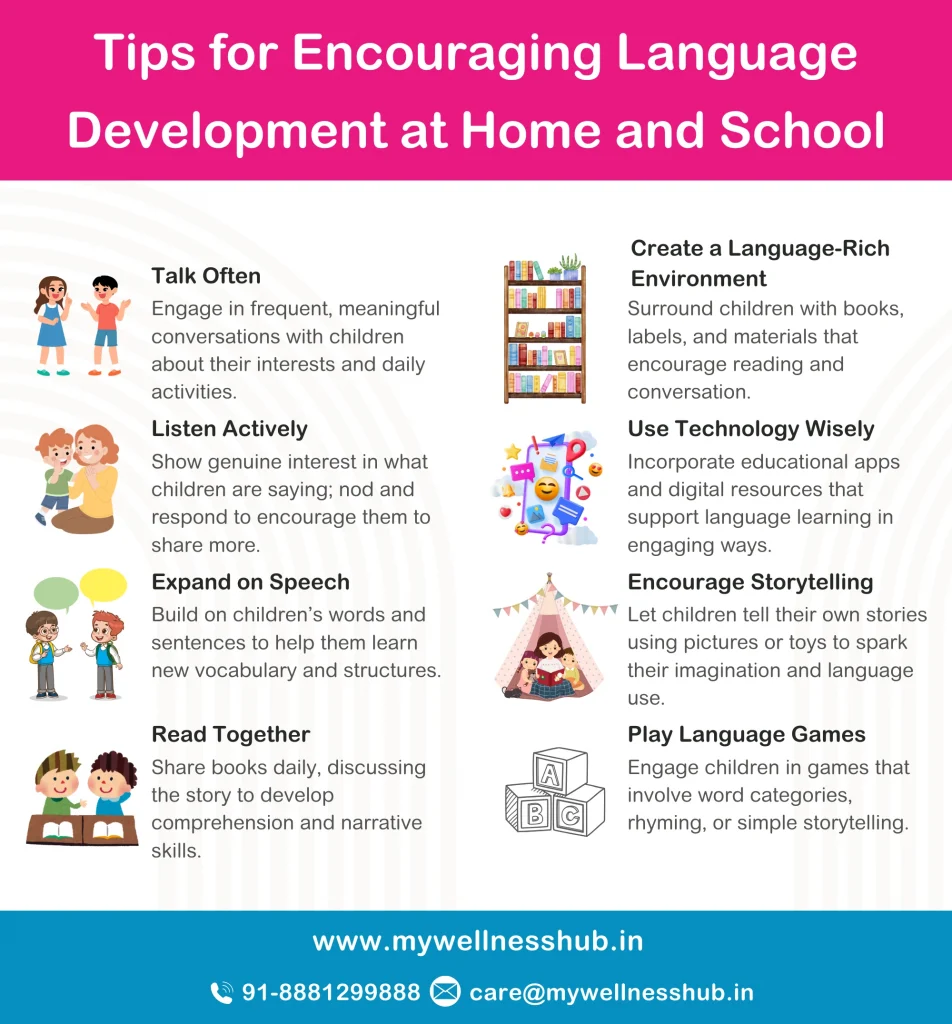
Fostering strong language skills is essential for a child’s overall development and success, both academically and socially. Parents and educators can play pivotal roles in this process by providing rich language environments at home and in the classroom. Here are some practical tips to effectively support language development, along with insights into the importance of reading, storytelling, and the use of technology.
Practical Tips for Parents and Educators
Supporting language development doesn’t require elaborate plans or expensive resources. Simple, consistent actions can make a significant impact:
- Talk Often: Engage in frequent conversations with the child, describing your actions and surroundings to enrich their vocabulary and comprehension.
- Listen Actively: Show interest in what the child says to encourage more communication and deeper conversations.
- Expand and Extend: When a child uses simple phrases, expand on them. For example, if a child says, “dog big,” you might respond, “Yes, that’s a big, brown dog.”
- Create Language-Rich Environments: Surround children with books, labels, and interesting objects that spark curiosity and verbal interaction.
Strategies to Encourage Language Development
| Strategy | Description | Setting |
| Talk Often | Engage in regular conversations about interests and daily activities. | Home & School |
| Listen Actively | Show interest in children’s talks to encourage more communication. | Home & School |
| Expand on Speech | Build on children’s words to teach new vocabulary and sentence structures. | Home & School |
| Read Together | Share books daily and discuss stories to improve comprehension. | Home |
| Create a Language-Rich Environment | Fill the surroundings with books, labels, and educational materials. | Home & School |
| Use Technology Wisely | Incorporate educational apps and resources that support language learning. | Home & School |
| Encourage Storytelling | Allow children to tell their own stories using pictures or toys. | Home & School |
| Play Language Games | Use games that involve word categories, rhyming, or storytelling. | Home & School |
The Power of Reading and Storytelling
Reading and storytelling are foundational activities that significantly enhance language acquisition:
- Routine Reading: Establish a daily reading routine that not only improves vocabulary but also helps children understand narrative structures and abstract language concepts.
- Interactive Storytelling: Encourage children to tell their stories or recount their day. This practice develops narrative skills and allows children to experiment with new vocabulary and grammar in a meaningful context.
- Library Visits: Regular visits to the library can turn into adventurous quests for new books, exposing children to a variety of subjects and writing styles.
Leveraging Technology in Language Learning
Technology, when used appropriately, can be a fantastic supplement to traditional learning methods:
- Educational Apps: Apps designed for language learning can provide interactive experiences that are both engaging and educational. Look for apps that encourage active participation and offer feedback.
- Audiobooks and Podcasts: These can expose children to complex language, different accents, and new ideas, enhancing their listening skills and comprehension.
- Games and Interactive Media: Select games that promote problem-solving and narrative understanding, which are essential components of language development.
Conclusion
Supporting language development is key to helping children communicate better and connect with others. Whether you’re a parent, teacher, or therapist, every conversation and activity counts towards building strong language skills. Use the tips and strategies shared here to enrich your child’s learning environment and encourage their language growth.
Visit Wellness Hub for more resources and guidance to assist you on this journey. Together, we can make a positive impact on children’s lives by nurturing their ability to express themselves clearly and confidently. Let’s empower every child to reach their full potential with strong communication skills!
Frequently Asked Questions:
1. What age should my child start talking?
Children typically begin speaking their first words around 12 to 18 months of age. If your child isn’t saying simple words like “mama” or “dada” by 18 months, it might be wise to consult a pediatrician or speech-language pathologist to ensure their language development is on track.
2. How can I help my child learn two languages at once?
To raise a bilingual child, consistently expose them to both languages in everyday situations. For example, one parent could consistently speak one language to the child, while the other parent speaks another. Regular interaction in both languages helps build a strong bilingual foundation.
3. What are signs of language delay in toddlers?
Early signs of language delay include a lack of gestures like pointing or waving by 12 months, limited or no babbling, and not using words by 16 months. If your toddler isn’t combining words by 24 months, it may indicate a language development issue.
4. Can reading daily help my child’s language development?
Absolutely! Daily reading enriches a child’s vocabulary, aids in understanding complex language structures, and helps develop listening and attention skills. It’s a powerful tool for boosting both language and cognitive development.
5. What role do schools play in supporting language development?
Schools enhance language development through structured learning environments that integrate language skills across subjects. Educators provide critical support through direct instruction, interactive discussions, and literacy programs, catering to diverse linguistic needs.
6. How can technology aid in my child’s language learning?
Technology, when used appropriately, can complement traditional learning methods effectively. Educational apps and digital games engage children with interactive and visually stimulating content that reinforces language concepts in a fun, engaging way.
7. When should I worry about my child’s speech and language development?
Concerns about language development may arise if your child shows significant delays in speaking or understanding others compared to peers. Common benchmarks include not babbling by 12 months, not speaking single words by 16 months, or not making simple sentences by two years.
8. How does bilingualism affect children’s language development?
While initial language development may appear slower in bilingual children as they navigate two linguistic systems, the long-term benefits include enhanced mental flexibility, improved problem-solving skills, and superior multitasking abilities.
9. What are effective ways to encourage language development at home?
Engaging your child in daily conversations, reading together, playing interactive games, and incorporating storytelling are effective ways to stimulate language development. Consistently responding to and expanding on your child’s verbal expressions can also greatly support their language skills.
10. Where can I find resources to support my child’s language development?
For resources specifically tailored to boosting language skills, visit Wellness Hub’s Home Therapy Resources. You’ll find a range of tools, tips, and materials designed to support both parents and educators in fostering effective language development.
About the Author:
Rajini Darugupally
M.Sc., Speech-Language Pathologist (9+ years of experience)
Rajini is a passionate and dedicated Speech-Language Pathologist with over 9+ years of experience, specializing in both developmental speech and language disorders in children and rehabilitation in adults. Currently, at Wellness Hub, she thrives in a team environment that values innovation, compassion, and achieving results for their clients.
Book your Free Consultation Today
Parent/Caregiver Info:
Client’s Details:
* Error Message





